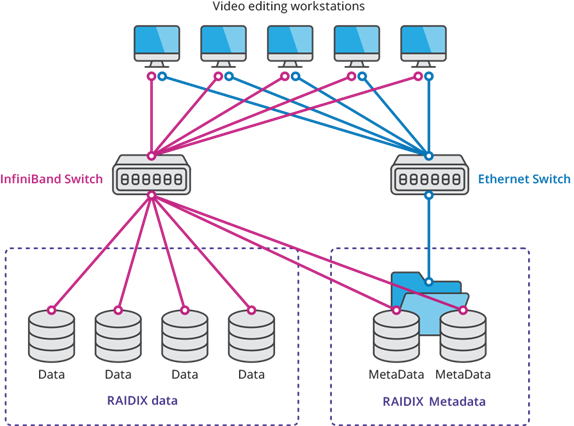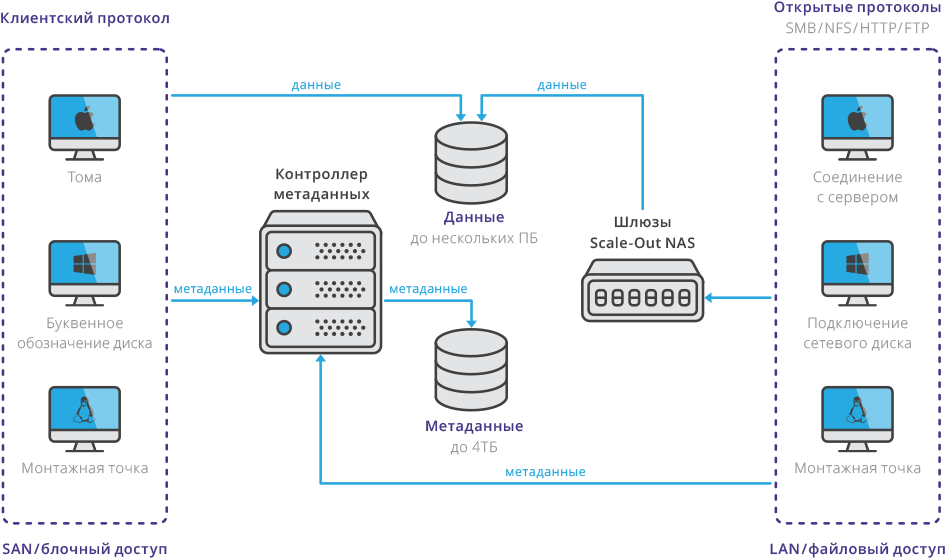Highly scalable storage for post-production studios and TV channels

Post-production studio specialists operate on terabyte-sized files and perform video editing, color correction and final processing of the material with the help of demanding professional applications. The key task for the studios is to maintain high bandwidth, sufficient for uninterrupted work on video without loss of frames and delays, as a rule, from several workstations.
At the same time, taking into account the growing volumes of video data and limited storage capacity, post-production studios and TV channels need highly scalable solutions. Often, when it comes to petabytes of information and cluster storage, there is a need for horizontal storage scaling.
In this article, we will talk about typical media company tasks, performance metrics and Scale-Out solutions based on RAIDIX and the highly scalable Hyper FS file system for large IT infrastructures.
')
Growing amount of data
Efficient storage of large files in various industries, for example, in diagnostic medicine or resource-intensive research, becomes a daunting task. As for the media industry, there are huge amounts of content. Thus, a medium-length feature film can take up to 2 TB of data in Full HD format and up to 15 TB in 8K format.
With multiple parallel projects and petabyte volumes of video data, it is logical to create a storage cluster of several nodes. In performing this task, the system administrator faces several limitations of traditional file systems: the location of metadata and data in the same sections; lack of scalability in size, performance, number of files, nesting of folders, etc .; problems with cross-platform, etc. The optimal solution in this case becomes a distributed cluster file system.
Data storage in the field of video production
Among the key requirements for storage systems in the field of video production and broadcasting can be identified:
- high bandwidth and low performance even in the event of disk failure;
- the possibility of "hot-swappable hardware elements without downtime;
- ability to set priorities for applications used in the process;
- flexible support for Fiber Channel, iSCSI, NFS, SMB, FTP, AFP data access interfaces;
- high vertical and horizontal scalability of the system.
Video editing data implies the need to read and write data in real time and work with streams of uncompressed video. Storage delays can lead to frame loss, in which case the process will have to be restarted. The key task for film studios is video processing in the shortest possible time. In the technical plane, this requirement implies high bandwidth and fault tolerance of equipment at all stages of working with video.
Media holdings working with dozens of parallel projects need new data storage systems or upgrades of existing configurations in view of increasing video content. Such a storage system should provide high-performance and reliable storage of petabyte data volumes with minimal investment.
Scale-out solution for the media industry
When working with high loads, it is necessary to respect the ratio of performance, storage density and cost. System performance depends on the number of disks and on the performance of each individual disk. As a rule, high-performance software-defined technology using rotating disks fully satisfies streaming tasks. In combination with high-density shelves, efficient configurations are created for working with a large number of streams or with high-resolution streams.
If further scaling is needed, cluster solutions can be used, such as systems based on RAIDIX software and the HyperFS cluster system.
Key criteria for a horizontally scalable solution, in addition to high performance and low latency, are:
- single address space for multiple storage clusters;
- simultaneous access using different protocols;
- file and block access to the same data.
For example, let's take a system with a large storage capacity (from 2U / 48TB to 4U / 108TB) based on RAIDIX with the ability to connect additional disk shelves, high performance and support for 2K / 4K multiple video streams. Data integrity without loss of frames is ensured by Raydix’s proprietary algorithms, including RAID 6 with double parity and 7.3 with triple parity. Thus, RAID 7.3 ensures uninterrupted operation of the system with minimum performance even in case of failure of up to 3 disks of the array.
RAIDIX as management software works with standard x86-64 components (enclosures, disks, interface controllers, memory, processors, etc.), allows you to optimize RAID arrays for specific holding tasks and reduce the overall cost of system maintenance.
The RAIDIX solution supports hardware, AJA, Blackmagic Design, successfully interacts with Xsan, metaSAN, StorNext, FalconStor control environments and professional editing applications (Adobe Premiere, Final Cut Pro, Avid, Smoke, DaVinci Resolve, SGO Mistika, etc.). In addition, RAIDIX allows you to install professional color correction software directly on the storage node, thereby saving hardware resources.
Cluster file system
What are the scenarios for using RAIDIX to create a multi-node storage cluster? As mentioned above, the functionality of traditional file systems (FS) is not sufficient for this task. Classical FSs are characterized by the following limitations:
- metadata and data are stored on the same sections;
- files are spread over the section, and access delays occur;
- there is no defragmentation prevention mechanism;
- insufficient scalability in size, performance, number of files, nesting of folders, etc .;
- "Non-native" cross-platform.
These problems are solved using cluster file systems. Thus, Scale Logic's HyperFS system provides high scalability for the client transparently and simultaneous access to data from various operating systems (in particular, through file gateways). RAIDIX software in conjunction with HyperFS allows you to organize a single address space for block and file access. Among the technical advantages of a joint solution:
- up to 4 billion files in one directory;
- up to 4096 partitions that can be merged into one FS;
- lack of a single point of failure;
- Dynamic expansion of FS in capacity and performance without downtime;
- Support for the latest versions of popular OS - Mac / Windows / Linux.
The HyperFS SAN file system (Figure 1) provides the necessary redundancy, high data availability, path and data mirroring. HyperFS for SAN allows you to transform multiple file systems or iSCSI disk arrays into a storage cluster that supports simultaneous editing and playback of data from multiple client machines, provides high performance and shared access within a single namespace.
The system has an optional metadata controller (MDC) with a redundancy structure, a full redundancy SAN structure with metadata mirroring and supports configuration with multiple paths in an Fiber Channel and iSCSI environment. The system does not have a single point of failure and provides high storage stability.

Fig. 1. HyperFS SAN structure
The capabilities of Scale-Out NAS systems used in large media and entertainment infrastructures include consolidation of up to 64 nodes in a cluster, simultaneous access using different protocols (SMB v2 / v3, NFS v3 / v4, FTP / FTPS, HTTP / HTTPS / WebDAV), load balancing between nodes (Round-Robin, Connection Count, Load node), support for Active Directory.
Extended RAIDIX and HyperFS features:
- system optimization for large and small files;
- support for user quotas and folders;
- SNMP monitoring via SNMP for SONG and MDC;
- LDAP / Active Directory - the ability to use a local user base or integrate with Active Directory;
- ACL support - the ability to use ACL on all supported operating systems.
Thus, a system based on RAIDIX and HyperFS provides film studios, postproduction studios and television channels with a solution with high performance, a single address space, simultaneous access via various protocols, low latency, high extensibility, file and block access to the same data.
Solution Architecture
The storage architecture (see Figure 2) based on RAIDIX software and the HyperFS cluster file system consists of three main components:
- Storage nodes (SharedDisk / storage). Disk storage systems designed for fault-tolerant information storage
- Directory Services (MDS). Designed to store links to data, arbitration and access control. The data and metadata of the directory service itself are not stored.
- Customers RAIDIX clients can be servers or PCs with specialized client software installed to access shared data.
If you need to connect a large number of clients - without installing client software on them - the solution architecture provides for the possibility of organizing file access gateways (NAS Gateway) through which data is handled.

Fig. 2. RAIDIX-based storage system and cluster file system architecture
Technical indicators
| System capacity | 64 ZB (theoretical limit) |
| Maximum number of files / objects / folders | Up to 4,000,000,000 using a 4 TB metadata volume |
| file size | 64 ZB (theoretical limit) |
| File name length | Windows: 255 ASCII characters; Linux / Mac: 255 ASCII characters |
| Catalog depth | Windows: 244 characters; Linux: 4096 bytes |
| Maximum LUN | 4093 |
| Exported Ways | 512 |
| Number of Metadata Controllers (MDC) | Up to 2, can be configured in high availability mode |
| Number of concurrent file systems | sixteen |
| Full redundancy | Supported: no single point of failure |
| Dynamic file system extension | Yes, LUNs can be added without downtime. |
| SAN Client OS Supported | Windows 7 32 / x86_64 / Win 8, Win 10 Windows 2008 / 2008_R2 / 2012 / 2012_R2 / Server 32 / x86_64 / 2016_x86_64 SUSE 11 SP1-3 OS X 10.7-10.12 |
| SSD support | Yes |
findings
The RAIDIX solution allows you to use multiple storage nodes (DSS), dynamically distributing information between them and balancing the load. The solution architecture allows adding new storage nodes to the system on demand - without the need to transfer data and change the system configuration.
The main advantage of RAIDIX is the ability to perform at the block level with high performance simultaneous work with data stored on one or several storage systems from a large number of workplaces, which is impossible in the classical SAN architecture.
RAIDIX technology in combination with the HyperFS file system meets the highest requirements for speed and fault tolerance, and provides simultaneous work with video content from several workstations. Using RAIDIX allows you to minimize the cost of hardware upgrades when creating storage clusters, horizontally expanding the existing infrastructure without downtime and performance degradation.
Source: https://habr.com/ru/post/347880/
All Articles